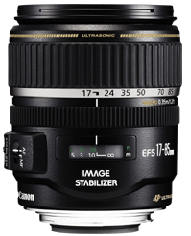Page 1 - Introduction
|
|
There are plenty of choices of
"standard" zooms for the EOS 20D. I bought the one which
seemed, from various info
on the net
(links at the end of this article) to be the best compromise for
me - the Sigma 18-50 f2.8. My key reasons were these benefits
compared to the Canon 17-85 IS: - Two whole stops faster at 50mm - Slightly smaller and lighter - Cheaper (by nearly £200). |
|
|
However I ended up with the Canon lens,
after testing two (surely defective) copies of the Sigma. I'm
very happy with the Canon lens, which has the following benefits
over the Sigma: - Image Stabilisation - Consistent build quality - Consistent sharpness from centre to edges - Longer zoom range - Silent and faster (more accurate?) autofocus. |
Two big surprises arose from my testing. First is how worrying Sigma's quality control is. Details and samples are on the following pages. I expect there are good examples of the Sigma lens out there, but I got two bad ones. They both had the same fault, but the second one was better than the first. Choosing between a good example of the Sigma (on the assumption that there is such a thing) and the Canon would be a difficult decision, even if money was no object. But I don't have enough time for my photography as it is, and life is too short to spend it doing Sigma's quality control testing for them, so the Canon was an easy choice.
The second surprise is that IS is much more valuable than I thought. I had been of the view that a faster, non-image stabilised lens would clearly give more creative control than a slower, image stabilised one. With the sensor in the EOS 20D being smaller than 35mm film, and the consequent 1.6X cropping/magnification effect, I felt a key feature of a standard zoom would be a fast enough aperture to be able to blur out unwanted backgrounds. The Canon's maximum aperture from about 45mm up to 85mm is f5.6, which is two stops slower than the Sigma and just didn't seem fast enough.
What I didn't realise is that IS brings its own creative opportunities. There are things you can do with a Canon 17-85 IS which you can't do with a Sigma 18-50 f2.8. Whereas fast apertures give you more creative control over depth of field, IS allows you to make motion blur a part of your (otherwise sharp) hand-held photos.
The Magic of IS
I knew IS worked because I've seen examples on other websites demonstrating the fact. I have never been a good hand-holder, and usually aim to shoot one stop "faster" than the 1/focal length rule. 85mm on the EOS 20D is equivalent to 135mm on film, so at 85mm on this lens the rule tells me I need at least 1/135th of a second, which should be rounded up to 1/250th to be on the safe side. The picture below was hand held at 85mm with an exposure of 1/3 second - nearly six stops slower than the rule of thumb would require. It's not quite as sharp as it would have been with a tripod but even for an A3 print it is perfectly useable with a bit of sharpening.

full frame resized

section of above at "actual pixels" resolution.
Before I got my hands on the Canon lens, I always thought of IS as a second-best substitute for faster aperture. But the real beauty of IS is that you can add a real sense of movement to your photos in the same way you can with a tripod, but can't with a fast, non-stabilised lens.
 This
fountain at Trafalgar Square was shot with the Canon 17-85 IS at 85mm,
with a shutter speed of 1/6th of a second at f32 (about 5 stops slower
than you could safely hand hold without IS). The details on the
fountain and the building in the background are sharp, but the long
exposure has given the water a fluid look. Without IS, a shutter
speed of 1/135th of a second would have been needed to keep the details
sharp. Using such a fast speed would have given the water a
completely different, "frozen" look. With the 18-85IS, you
get to choose which look you want. Ironically, even on a dull
overcast London April afternoon, there was almost too much light - I
needed to use the slowest ISO setting (100) and the smallest available aperture
(f32) to get the motion blur I
wanted.
This
fountain at Trafalgar Square was shot with the Canon 17-85 IS at 85mm,
with a shutter speed of 1/6th of a second at f32 (about 5 stops slower
than you could safely hand hold without IS). The details on the
fountain and the building in the background are sharp, but the long
exposure has given the water a fluid look. Without IS, a shutter
speed of 1/135th of a second would have been needed to keep the details
sharp. Using such a fast speed would have given the water a
completely different, "frozen" look. With the 18-85IS, you
get to choose which look you want. Ironically, even on a dull
overcast London April afternoon, there was almost too much light - I
needed to use the slowest ISO setting (100) and the smallest available aperture
(f32) to get the motion blur I
wanted.

